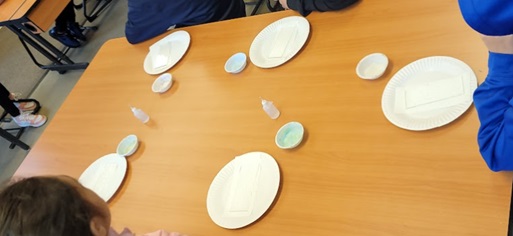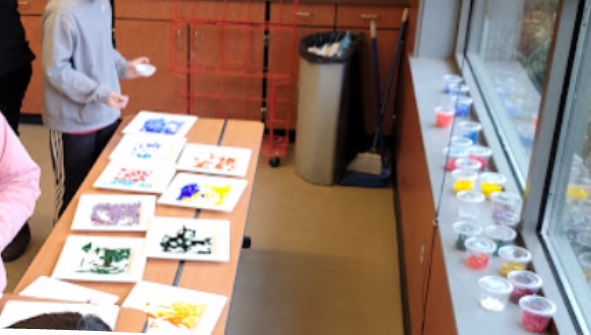
(PPT is on the thumb drive)
Prepare students for taking home their projects by asking them to bring in padded envelopes from online shopping purchases at least a month prior to lesson date. This saves on the budget for packing materials when sending projects home.
The following information is to educate the Art Docents who are leading the Fused Glass projects
About Glass -
Glass is an amorphous solid. It does not have crystals, it is actually a liquid that is hard at room temperature.
Glass naturally wants to be 6mm thick. If layering glass, use glass that is 2mm thick and you can't go higher than 3 layers.
If 3rd layer doesn't completely cover the bottom 2 layers, it will warp a little on the sides as it pulls up the shorter layers to become 6mm thick.
If you have more than 3 layers, the glass will spread out (widen) to reduce its height to get to 6mm thick.
Its okay, to have 2.5 layers of glass (where the 3rd layer doesn't completely cover the 2nd layer) plus Millefiori, stringers and noodles as accents.
Types
Coefficient of expansion (COE)
Transparency
Forms
Surface treatments
Glass Manufacturers
Inclusions\ Additions
Any material encapsulated between two layers of glass.
Fusing process
Basic tools / Supplies

Supplies needed for class
Sources
Safety
Cutting Glass (Adults only)
Classroom management




Kiln Preset Programs
To fuse separate glass pieces together successfully, the pieces must be similar in expansion characteristics. Which means, use compatible glass in the same project, that of the same COE number.
Our Creekside Kiln has been programed for the following glass co-efficiency types and forming methods:
96 COE Glass (*used by 5th grade)
Full Fused
Glass pieces are completely conjoined into a single uniform layer. Top surface is smooth and void of dimension or relief.
Program 1 ![]()
Contour Fused
Glass pieces are fused together, edges are soft and rounded, project surface retains a degree of dimension
Program 2 ![]()
Tack Fused
Glass pieces are fused together with little deformation beyond softening or rounding of edges
Program 3 ![]()
90 COE Glass (cooler temperatures)
Full Fused - Program 4
Contour Fused - Program 5
Tack Fused - Program 6
Resources: